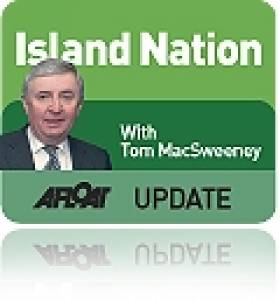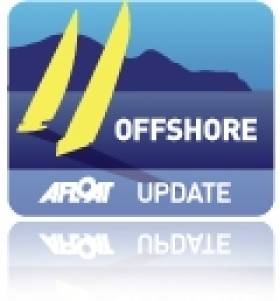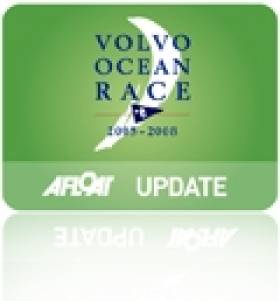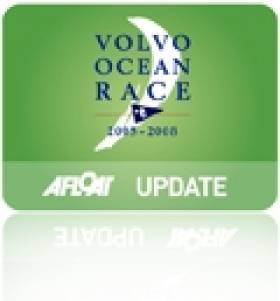Displaying items by tag: Damian Foxall
Champion Jean Pierre Compares Foxall and Peyron
Jean Pierre Dick has been talking about preparations for the defence of his title later this month in an interview on the Barcelona race website. He won the global double-handed race in 2008 with Kerry's Damian Foxall. In the latest interview Dick gives a few interesting insights on Ireland's top offshore sailor and how sailing with him compares with Dick's current partner, the famous French offshore sailor Loick Peyron.
Excerpts below and full article HERE
What are the main differences between Damian and Loïck as sailors and who will how you work together compare with last time?
" Last time Damian was more looking after the boat, if there were things to repair he was the man and maybe more at the front of the boat, I was more into picking the weather. Now with Loïck it will be more equivalent, I will be more equal on the repairs this time which is good for my training for the Vendée Globe. And for sure Loïck is very knowledgeable on his weather analysis, so we will work together. If there is a security decision I am the skipper and the owner of the boat, and the project, and they are my sponsors, so that becomes my task, but I want Loïck to be involved in the strategy and the thinking in this race. In this race what makes you successful is the interaction between the two skippers. It is important that we know work well together, we have done some training together and we have done some weather analysis together, so there will be the same level of information."
What are the main differences between the two?
" Loïck has such huge experience, Damian also has huge experience but it is coming more from the Volvo also, Loïck's (experience) is more....well, everything sailing! So I would say the main difference is Damian is a very physical guy, very strong. Loïck is more using his brain to sail smart, to make less effort. So that is how I see things, but there is a change for sure but I will learn more about both experiences as we go. Loïck has more experience with single and double handed races, maybe I would say more experience over his while life. Damian has been more on more physical races like the Volvo. Both are very able to repair the boat, to sail the boat on their own, they would have been able single handed even though Damian did not do more, he would be very talented to do so."
Damian Foxall is First Choice
"When Damian is on a project, it is often the winning one. As such, it is better to have him with us rather than against us."
That tribute to Damian Foxall comes from Franck Cammas, renowned amongst the top sailors in the world. In France his sporting fame lies somewhere between rock star and iconic status. He has a record-breaking career. This year he added two world races to his achievements, the Jules Verne Trophy and the Route du Rhumm.
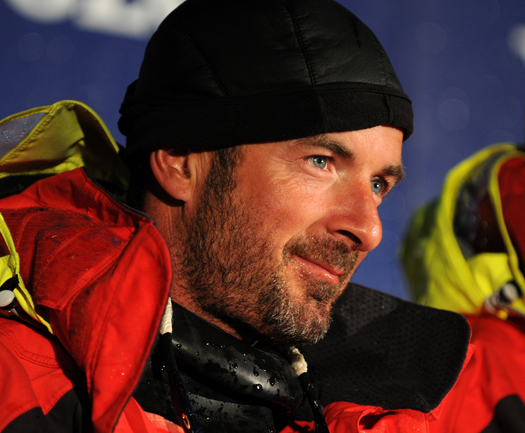
Ireland's Offshore Ace Damian Foxall has joined Groupama for the next Ocean Race
He races "anything and everything that floats" and his reputation is so strong that the huge worldwide Groupama insurance company has committed over a decade of sponsorship support to his projects. In return he has carried their name on a winning partnership with five world records amongst the list of successes. That kind of dedication from a backer is almost unheard of in any sport and has provided the financial muscle to confirm that Camas will lead the entry of boats into the Volvo Ocean Race around the world until 2015.
"Our commitment is to a race that, given its longevity on the circuit, has a human dimension and an international relevance," said Groupama Managing Director Jean Azéma. "We chose the Volvo to promote our image and share the benefit with Franck Cammas who is a sporting icon. Both of us, through the boat named Groupama, are interested in the values of building a boat, a sport and a reputation, with human interest. This is something that will last."
That huge commitment contrasts with the on-going financial struggle to enter an Irish boat. Damian, who crewed the last Irish entry, the Green Dragon, is no longer available, having been given a huge endorsement and tribute by Cammas who chose him first as an essential part of the Groupama entry.
He named the Kerryman, from Derrynane, as the first sailor he wanted aboard. Foxall, at the age of 41, is arguably the most French of Irishmen. Now resident in Lorient, he has taken part in three Volvo Ocean Races and won the last Barcelona two-crew non/stop round-the-world race with Jean-Pierre Dick.
He has been appointed to three responsibilities, as Helmsman, Trimmer and Crew Manager and is enthusiastic about going around the world for a sixth time, having also been part of a non/stop world speed record:
"I have been involved with Franck since the outset of this entry. The greatest challenge is to drive Groupama 4 at one hundred per cent of her potential at each of the nine stages of the race, with very little time during the stopovers. In a nine-month race fatigue accumulates. At the end, you really feel that you've done a circumnavigation of the globe."
Damian has worked alongside Cammas to select the sailing crew for next year's race. They include top international sailing names: Philip Harmer, Magnus Woxén, Jean-Luc Nélias, Charles Caudrelier, Sébastien Josse, Yann Riou, Jacques Caraës, Martin Krite, Brad Marsh, Martin Strömberg, Erwan Israël and Sébastien Marsset.
The Groupama project bought the winning boat in the last Volvo Race, the Volvo 70, Ericsson 4, which they rechristened, Groupama 70 and which they have been using for training. That shows their financial resources.
For the design of Groupama 4, their new boat for the 2011 event which will start next October, they turned to Juan Koujoumdjian, who was involved in building the last two winning Volvo boats, Ericsson 4 and ABN Amro One. The design is being tested in sailing trials off Lorient in Brittany where the team is based and which is Foxall's home base.
Cammas has put together a strong Groupama Sailing Team, with Foxall's input. Another Green Dragon sailor has been chosen as Pitman, Master Sailmaker and to back-up Damian as Helmsman and Trimmer. He is Australian Phil Harmer for whom this will be his third Volvo: "I feel really lucky to be in the Groupama Team. I sailed with Damian on Green Dragon and he called me to ask me to join. Since then I've had other offers, but I don't want to leave Groupama. There's a strong sense of involvement and no other team is in a position to do better."
This article is reprinted by permission of the EVENING ECHO newspaper, Cork, where Tom MacSweeney writes maritime columns twice weekly. Evening Echo website: www.eecho.ie
Foxall to be Groupama Helmsman, Trimmer and Crew Manager
The Daily Sail website is reporting Foxall will take up the position of helmsman, trimmer and crew manager. More HERE.
Foxall Podcast from Volvo Ocean Race
Groupama in Lifeboat Fundraiser Race
The Groupama Volvo 70, with watch leader Damian Foxall, will be racing in aid of the French lifeboat service this weeken in a race created and organised since 2005 by French sailor Damien Grimont. The SNSM (Originally the Saint Nazaire St Malo) aims to promote safety at sea and support the volunteers, who rally together their members on a daily basis to offer assistance or emergency help to sailors.
Originally the SNSM record ran between Saint Nazaire and the pirate city of Saint Malo, but the route has since changed. This Sunday sailors will be required to race between Saint Nazaire and the pretty port of Sainte Marine, situated at the mouth of the Odet river.
Open to all types of boats measuring in excess of 6.50 metres, the record offers three courses, each of which relate to the speed of the participants and range between 180 and 360 miles.The largest boat at the start, Groupama 70 will have to make two return trips between Saint Nazaire and Sainte Marine, as is the case for the trimaran Gitana 11 skippered by Yann Guichard.Besides these two big names, no fewer than 56 competitors will take Sunday's start close to the port's eastern jetty between 1300 and 1400 hours local time.
Aboard Groupama 70, Franck Cammas has gathered together a large part of the crew who recently participated in the Transmanche race. Along with Jean-Luc Nélias, in charge of the navigation, we will find watch leaders Damian Foxall and Laurent Pagès, as well as Sébastien Josse, Erwan Israel, Sébastien Marsset, Yann Riou, Mike Parmenter, Philipp Harmer and Martin Krite. Another notable presence onboard comes in the form of Eurosport cameraman, Jérôme Dubarry.
Having to leave her home port of Lorient on Friday morning, Groupama 70 is expected into Saint Nazaire that same afternoon. As such the crew will, like the general public, have the opportunity to enjoy some sea rescue exercises performed by the SNSM, as well as a free concert given by the National Orchestra of the Pays de la Loire and a group called Jazz Band, who will provide an original interpretation of Tchaikovsky's "Nutcracker Suite".
"More than just a competition, the SNSM record is becoming a genuine festival of the sea for sailors on all manner of boats. Its popularity is a reflection of the responsibility we feel for supporting this organisation, which gives it all without a moment's hesitation, in what are at times difficult conditions. At Groupama we're naturally sensitive to this cause, which is why we won't solely be focusing on the sporting aspect when we take the start aboard Groupama 70. This event will also give us the chance to compare our performances with those of five participating IMOCA 60s and continue our preparation for the next Volvo Ocean Race" stated Franck Cammas, who will be joining his crew on Saturday evening, once he's had time to go out on the maxi trimaran Groupama 3, which has recently been revamped for solo sailing.
Foxall & Groupama to race Round Britain & Ireland
Damian Foxall and the Groupama crew have announced that the Shetland Round Britain and Ireland forms a major part of their Volvo Ocean Race preparation.
"We are going into the Transmanche across the channel race this month and then another race in June," said Foxall, "and then we are planning and it is all built up to the Round Britain and Ireland in September.”
Foxall has been heavily involved in selecting the Groupama team for the Volvo Ocean Race, a process that is nearly complete.
“We have more or less chosen our crew,” says Foxall. “We still have to confirm one or two slots, but we’ve started sailing with most of the guys already. By the end of September we want to have signed off the crew.”
“It was very important for us not to waste time," continues Foxall. "Even though you realise that last November the race might have seemed quite a long way away, as you get into it you realise that the race is already on. We are already coming up on deadlines with regard to the design and build of the new boat, like all the other teams are.
“So the time we spend on the water now, preparing the design and filling in the gaps with regards to what we know about the current boats and where we want to go with the new boats - it is a very important stage. So right now we are making decisions that will have basically a fundament bearing on the race results.”
This mixing of cultures has extended into the technical side of the campaign, for according to Foxall they have three sailmakers who were with other VOR teams in 2008-09. “In all areas - hether it is the sails, rig, boat, etc - most of the team has experience in working in both France and on the international circuit. That is hopefully one of our strong points.
Foxall has openly expressed disappointment with his three VOR campaigns to date, but feels that Groupama skipper Franck Cammas' involvement and enthusiasm for the project shows that the race has come of age.
"I am pretty motivated. I think the important thing from my point of view is that Franck [Cammas] and the sailing team proposed to Groupama the Volvo Ocean Race as a viable event and that shows the evolution of the VOR – especially in this edition where they believe it has got marketing and sporting value and the racing will be won on the water and not just with a chequebook.”
The full interview with Damian Foxall appears on the Volvo Ocean race homepage here
Virbac-Paprec 3 is Launched for Vendee Globe
Jean-Pierre Dick's brand new 60 foot monohull, Virbac-Paprec 3, has just been launched in Auckland, New Zealand. As for the first two boats, once again the design team has innovated and the VPLP Verdier plans mark a radical break with the two previous monohulls skippered by him. Afloat.ie readers will recall Dick was partner with Ireland's Damian Foxall when they won the Barcelona World race two years ago.
The French skipper now has a new vessel on which to go in search of the Holy Grail: the Vendée Globe 2012. Between now and then, the schedule is busy with a half round-the-world, the Route du Rhum and the Barcelona World Race.
What is the philosophy of your new boat?
Jean-Pierre Dick: "The philosophy is monastic! Virbac-Paprec 3 will be a very light boat and therefore spartan. Paprec-Virbac 2 was a palace in comparison! This is the ultimate boat for extreme races in which there is complete physical and moral involvement. I now have sufficient experience in offshore racing to do without the unnecessary and only to think of the objective! The only items of comfort will be the seats on board for steering and sailing preparation, a berth designed by a bedding specialist and two helm stations which are real cocoons."
What are the main characteristics of Virbac-Paprec 3?
" The bi-roof. We have created two cocoons under a Plexiglas dome to provide a perfect view; much as you would have in a helicopter. They will enable me to watch and steer in all weather and stay dry. Before, there were two distinct stations, so this means a reduction in weight. This work is a continuation of that carried out on Paprec-Virbac 2 with the sliding roof. The difference is that this time we agree to manoeuvre wet.
Lightness Virbac-Paprec 3 is 10 to 15% lighter than Paprec-Virbac 2. At each step in the construction, we found the means to simplify; to find a lighter and more intelligent way of building her. For example, the chart table is only a computer screen on a rotating stand with a seat that can be moved from one side to the other. The boat is completely empty inside! The advantage is the capacity to make quicker progress with less sails or to keep it longer. The skipper does less manoeuvring and saves more of his energy.
Hydrodynamics We have designed 70 hulls with architects. Four were retained and tested in the test tank. To finish, they sailed a virtual round-the-world routed by a meteorologist to make the final choice. The lines are very taut and they have sharp bilges.
Aerodynamics
We have a standard mast with two spreaders, but with only one backstay cable* instead of 3. This is an innovation to reduce weight and wind factor. Safety We have focussed on safety by learning from unfortunate experiences. We have designed a safety hatch in the centre of the hull, so as not to have to leave the yacht from the rear. This hatch is pre-cut in the carbon and I will be able to saw it open if I find myself upturned. We have strengthened the watertight bulkheads to prevent the boat from filling up with water completely, at all costs.
What is the Virbac-Paprec 3 programme?
"One of the advantages of building in New Zealand is the return journey to France by sea. This helps us to get to know and perfect the new IMOCA 60 in real sailing conditions and on a world scale. This requires a lot of involvement, since it lasts 2 months but is extremely rewarding for the team and I. When I arrive in Lorient in mid-July, the boat will already have sailed more than 12,000 miles (22,224 km), or the equivalent of three transatlantics. So this is a perfect test bench for the run up to a busy end of the year with the Route du Rhum and the Barcelona World Race, in which I will be defending my title!"

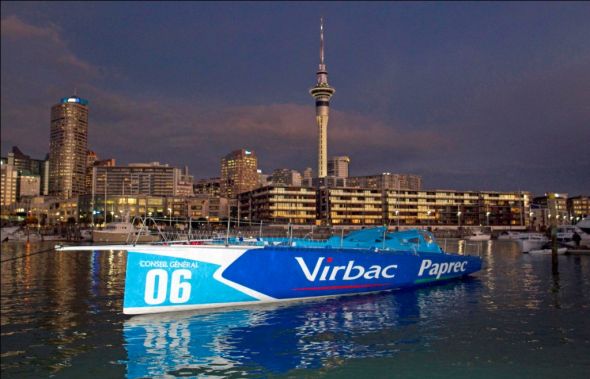

Groupama - The Green Team?
It's still more than a year until the start of the next Volvo Ocean Race, but we're aready looking at the runners and riders. With Groupama having snaffled two of the most experienced Irish heads in the game, namely Damian Foxall and boatbuilder Killian Bushe, there's enough emerald isle involvement to keep us interested in this Biscay-based boat. With no movement yet (as far as we know) on the proposed Irish team, they're the only group on the go within a decent radius.
Check out the below video to see the 'greening' of Groupama as they removed the Ericsson 4 livery and prepared to show their true colours.
Groupama plan includes Irish duo
Volvo Ocean Race veteran Damian Foxall and Killian Bushe, who has built the winning boat in the race on three occasions, are part of the team that hope to assist Franck Cammas' Groupama team to win the Volvo Ocean Race. Foxall is part of Cammas' core senior crew on board the boat, and has been involved in crew selection and campaign management from the outset. Bushe will spearhead the build of the boat from a French boatyard.
The French entry will be skippered by offshore specialist Franck Cammas. Speaking at an official event at Eric Tabarly's Cite de la Voile in Lorient, Cammas confirmed that the team already has a strong core of people working on the project."The challenge we've committed ourselves to is a sizeable one," says Cammas. "Since 1993 and Eric Tabarly, not a single French team has participated in the Volvo Ocean Race.
"Up against the top crews from New Zealand, America, Spain and Ireland, it's going to be an intense battle. We're just rediscovering monohulls and we still have a lot to learn.
"However, we're going about it with as much enthusiasm, seriousness and humility as possible. Thanks to Groupama's commitment, we were the first to put our team together."
Cammas's squad comprises a blend of experienced Whitbread/Volvo specialists and established members of the Groupama sailing programme. "Making up my entourage are Volvo specialists like Damian Foxall, Ben Wright, Luc Gellusseau, Herve Le Quilliec and Killian Bush who are joining together with long-term stalwarts of the Groupama team like Stephane Guilbaud, Pierre Tissier, Loic Dorez, Yann Riou and Olivier Mainguy," Cammas said.
Argentinean Juan Kouyoumdjian, the designer of the winning boats in the last two editions of the Volvo - ABN AMRO ONE (2005-06) and Ericsson 4 (2008-09) - has been chosen as designer for Groupama's new Volvo Open 70 - Groupama 4.
With the purchase of Ericsson 4, winner of the 2008-09 Volvo Ocean Race, the Groupama team has an ideal platform for training and development. Re-christened Groupama 70, the Koujoumdjian design is performing intensive sea trials off Lorient.
"Unfortunately we didn't have the time to involve the excellent French architects in the work, as they are also only just discovering the restrictions of the Volvo Open 70 rule," said Cammas.
"As such we opted for Juan Koujoumdjian, who is based in Valencia. However, it's actually in nearby Vannes, at the Multiplast yard, that Groupama 4 will be built. This will represent 40,000 man hours and we know the team there well because we built the maxi trimaran Groupama 3 with them."
Earlier this year, Cammas and his crew aboard the maxi trimaran Groupama 3 claimed the Jules Verne Trophy for sailing non-stop round the world - and broke through the 50-day barrier in the process.
Groupama 3's circumnavigation took 48 days 7 hours, 44 minutes and 52 seconds to beat the previous mark, set by Bruno Peyron's Orange 2 in 2005, by 2 days 8 hours, 35 minutes and 12 seconds.
With work having started on the new Volvo Open 70 in the last few days, construction will take 10 months until her scheduled launch on 15 March 2011.
In the meantime, Cammas will also take part in the Route du Rhum La Banque Postale aboard Groupama 3 but adapted to solo sailing, as well as the Extreme Sailing Series Europe aboard Groupama 40.
Groupama's entry extends a rich history of French links with the Whitbread/Volvo. In total there have been 21 French boats in the race and nearly 300 French sailors down the years.
Damian Foxall lifts Sailor of the Year Award
![]() Irish ocean yachtsman Damian Foxall was announced on RTE radio last night as Ireland's Sailor of the Year for 2008.Foxall, currently racing on board the Green Dragon, Ireland's entry in the Volvo Ocean Race, was selected by the judges for his outstanding contribution to Ireland's international maritime reputation.
Irish ocean yachtsman Damian Foxall was announced on RTE radio last night as Ireland's Sailor of the Year for 2008.Foxall, currently racing on board the Green Dragon, Ireland's entry in the Volvo Ocean Race, was selected by the judges for his outstanding contribution to Ireland's international maritime reputation.



























